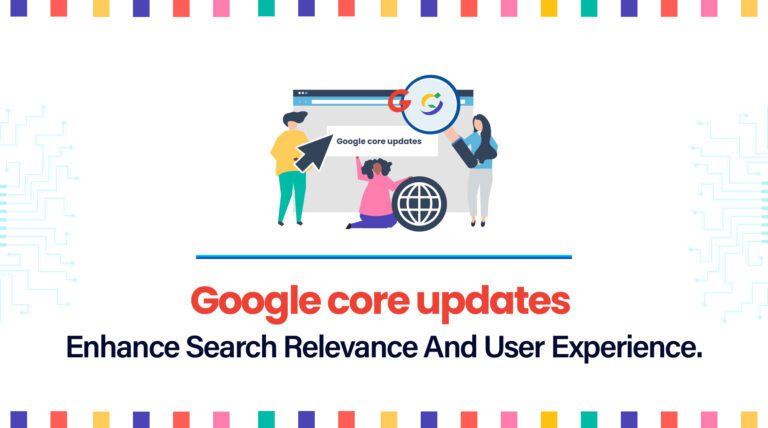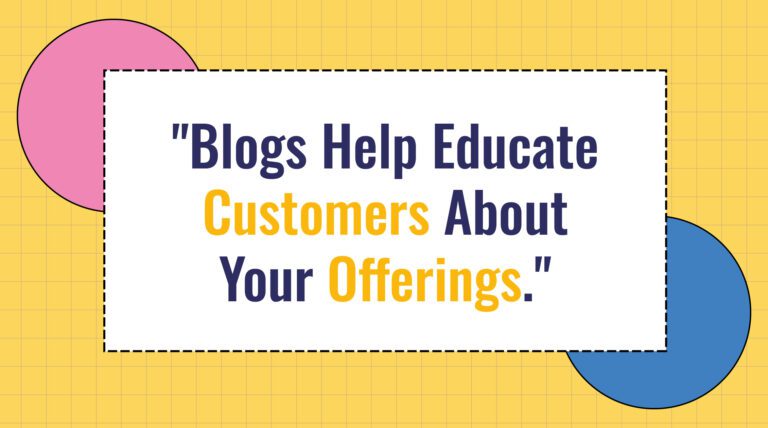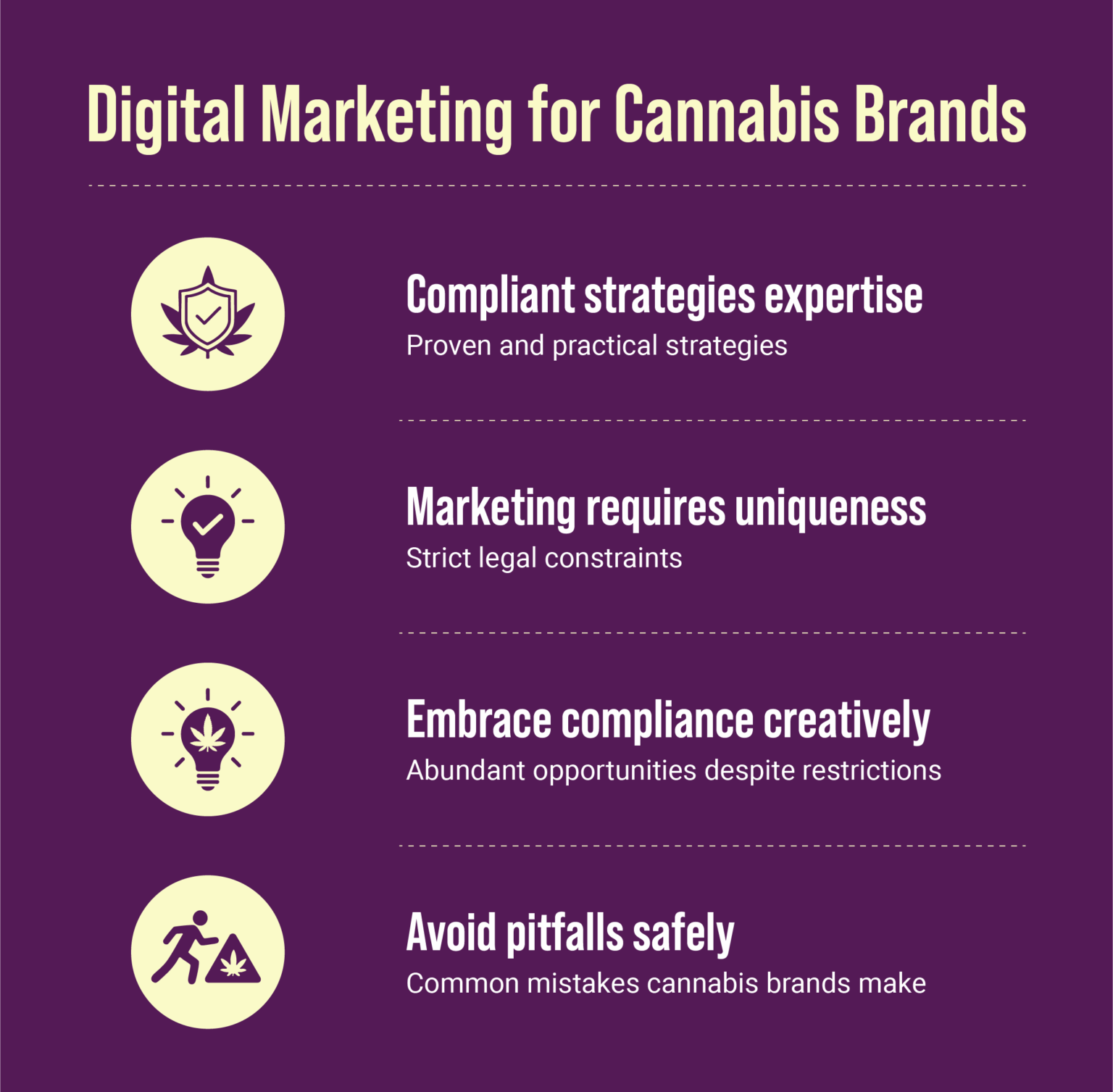
Cannabis businesses operate in a highly regulated, rapidly evolving digital landscape. Unlike traditional products, cannabis is subject to strict advertising rules, making standard marketing campaigns almost impossible to run without risk. Business owners often feel stuck — they want to reach potential customers but aren’t sure how to navigate social media restrictions, Google Ads limitations, or state-specific compliance laws.
You may have asked yourself:
How can my dispensary gain online visibility when Facebook, Instagram, and Google Ads restrict cannabis promotion?
What digital strategies can attract new customers without putting my business at legal risk?
How do I maintain consistent engagement with my audience when direct product promotion is off-limits?
If these questions sound familiar, you’re in the right place. This guide provides practical, compliant, and proven strategies for cannabis brands to grow online without getting banned. We’ll cover everything from SEO and content marketing to social media tactics, email campaigns, and alternative advertising methods. By the end, you’ll understand exactly how to reach the right audience, build trust, and drive sales while staying fully compliant.
Table of Contents
Section 1: Understanding the Cannabis Marketing Landscape
Before implementing any strategy, it’s essential to understand why cannabis marketing requires a unique approach.
1.1 Legal & Compliance Challenges
Cannabis marketing is unlike other industries because it operates under strict legal constraints:
Platform restrictions: Major advertising platforms such as Google Ads, Facebook, and Instagram restrict cannabis product promotion. Running ads without understanding the rules can result in account bans, financial penalties, and brand damage.
State-specific laws: Regulations differ across states. Some states allow recreational cannabis marketing, others only medical, while some have severe restrictions on digital promotion. Navigating this patchwork requires detailed attention to legal guidelines.
Content limitations: Even educational posts must avoid encouraging consumption in minors or making unverified health claims. Missteps here can cause serious legal or reputational consequences.
Understanding these constraints is the first step to building a compliant and effective marketing strategy.
1.2 Audience Behavior
Cannabis consumers behave differently than other product buyers. Studies show that over 70% of users research dispensaries online before making a purchase. They prioritize:
Trust: Customers want brands that demonstrate transparency and reliability.
Education: Many are unfamiliar with strains, dosages, or CBD/THC differences. Brands that teach win customer loyalty.
Local relevance: Cannabis users typically prefer local dispensaries they can visit, making local SEO critical.
By understanding these behaviors, your marketing strategy can focus on visibility, education, and trust-building — all within compliance.
1.3 Opportunities Despite Restrictions
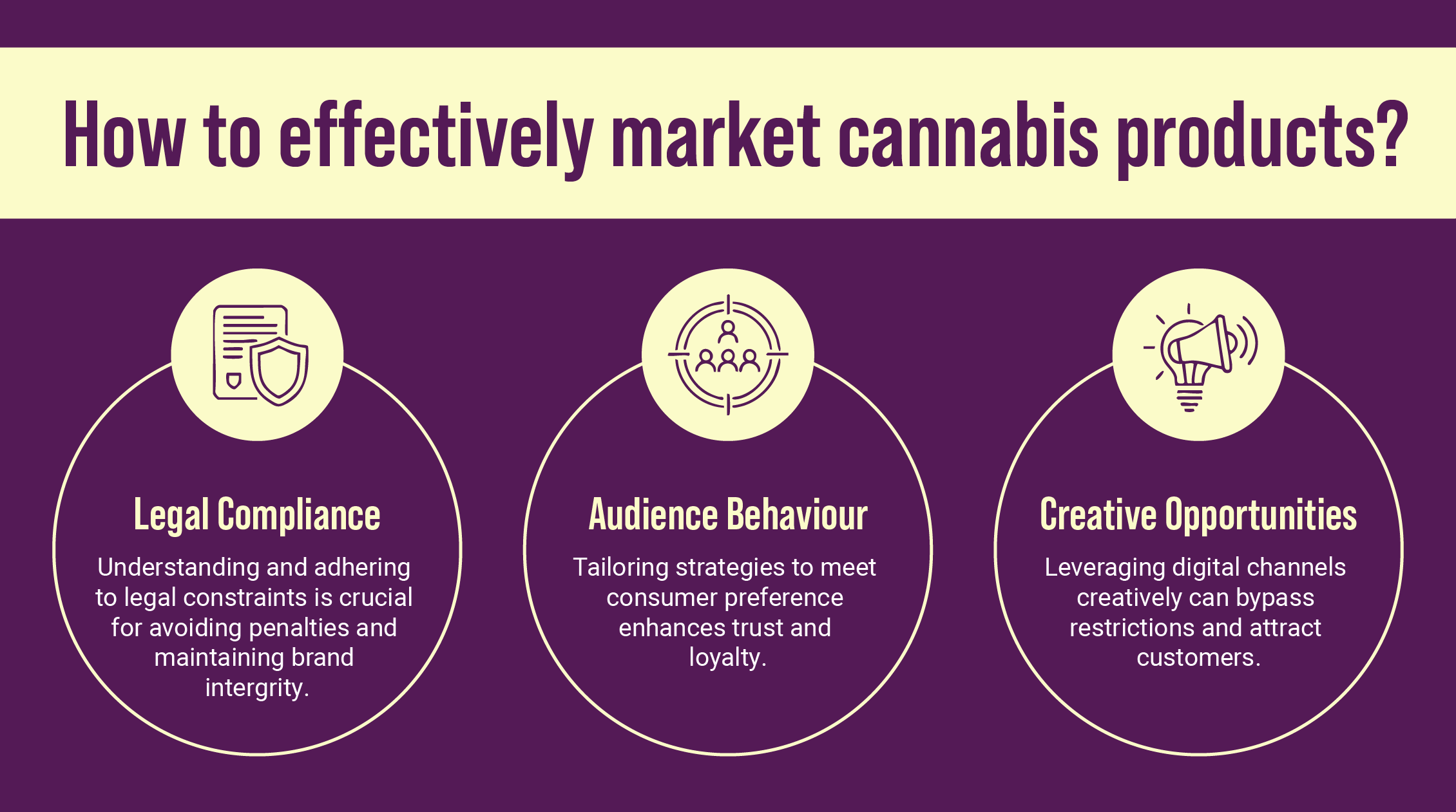
While cannabis marketing is challenging, opportunities are abundant:
SEO and content marketing: Organic search is unrestricted, meaning you can attract new customers without risking compliance.
Social media creativity: While direct product promotion is restricted, lifestyle, education, and community-focused content perform exceptionally well.
Email and retention campaigns: These channels allow direct communication with existing customers, building loyalty and repeat purchases.
The key is to embrace compliance creatively, using digital channels strategically rather than relying on paid ads alone.
Section 2: Building a Compliant Digital Marketing Strategy
Creating a successful cannabis marketing strategy requires a step-by-step approach that balances visibility, compliance, and conversion.
2.1 Define Your Goals & KPIs
Clearly defining your objectives ensures every marketing action aligns with measurable outcomes. Goals could include:
Increasing foot traffic: For dispensaries, the goal might be to increase in-store visits by 20% in six months. This can be measured via Google Maps “direction requests” and local engagement metrics.
Boosting online presence: A cannabis brand may aim to grow website visits by 50% through organic search and compliant social content. Tracking tools like Google Analytics help measure success.
Growing email subscribers: Many cannabis brands benefit from automated email campaigns. The goal might be to increase subscriber lists for educational content, promotions, and loyalty programs.
Pro tip: Use SMART goals — Specific, Measurable, Achievable, Relevant, and Time-bound — to ensure clarity and accountability.
2.2 Identify Your Target Audience
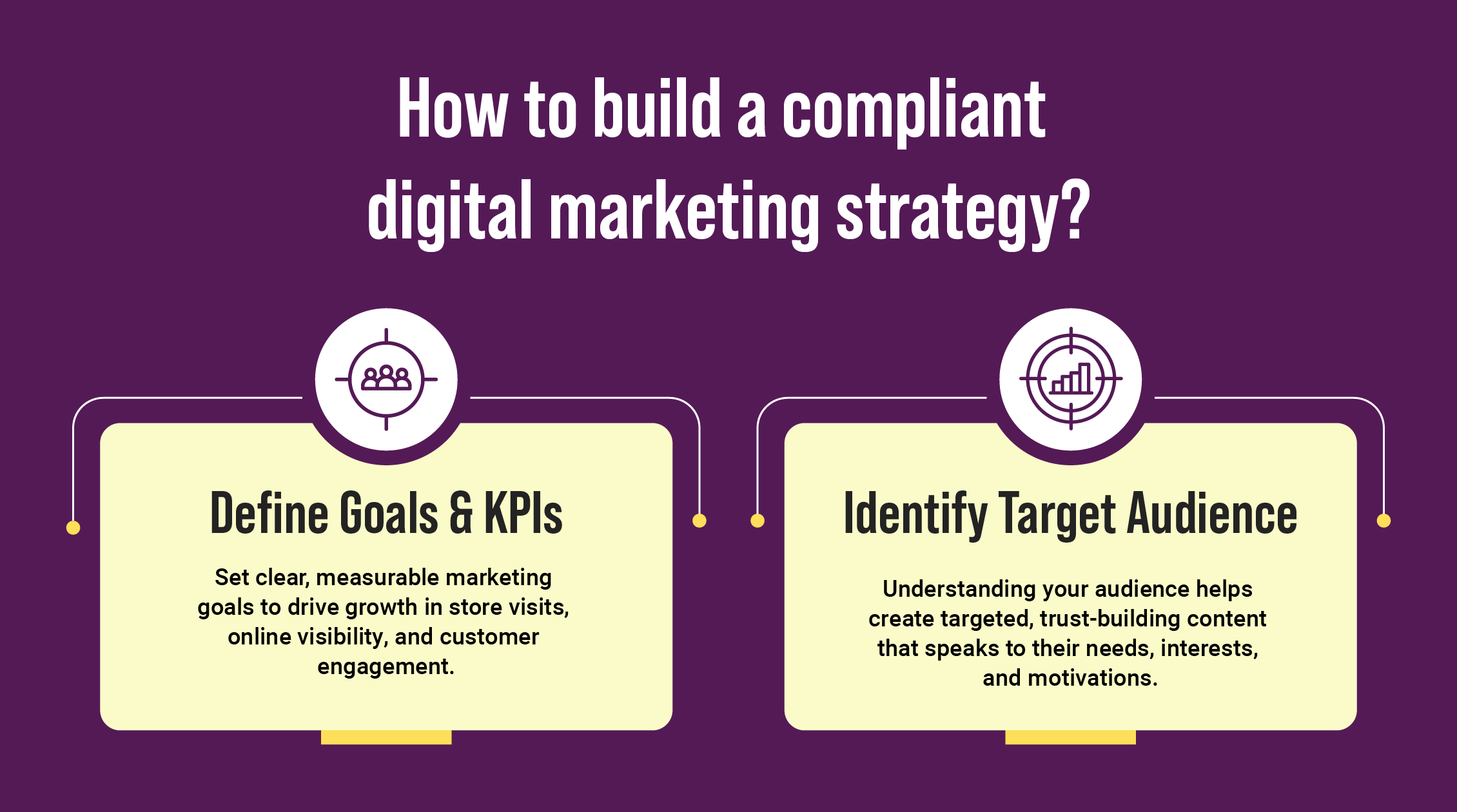
Knowing your audience allows you to craft content and campaigns that resonate:
Demographics: Age, location, and purchasing habits. Cannabis buyers vary widely, from younger recreational users to older medical patients.
Interests: Wellness, lifestyle, and community involvement are common motivators. Some may prioritize organic or vegan products.
Pain points: Difficulty finding trustworthy dispensaries, confusion about products, or concerns over privacy and legality.
Understanding these factors ensures your marketing content addresses real concerns, builds trust, and encourages engagement.
Section 3: Website & SEO — Your Digital Hub
Your website is the cornerstone of your digital strategy. It’s where traffic converts into trust and sales.
3.1 Local SEO Optimization
Most cannabis consumers are local, meaning local search optimization is critical. Key tactics include:
Google Business Profile (GBP): Claiming and fully optimizing your GBP ensures you appear in local searches. Include accurate NAP (Name, Address, Phone) and high-quality photos.
Customer reviews: Positive reviews enhance credibility and influence new customers’ decisions. Responding to reviews shows engagement and professionalism.
Localized content: Blog posts, landing pages, and metadata should include local keywords, e.g., “Best Dispensary in Denver for Recreational Cannabis.”
Example: A dispensary that optimized its GBP and implemented local keywords saw a 40% increase in in-store direction requests within three months.
3.2 Website Content Strategy
A cannabis-friendly website must educate and convert simultaneously:
Educational blog posts: Topics such as “Understanding THC vs. CBD” or “How to Choose the Right Strain” provide value while boosting SEO.
Guides and FAQs: Answer common questions clearly and comprehensively to help customers make informed decisions.
Video content: Walkthroughs, product demonstrations, and educational snippets engage visitors and improve time on site.
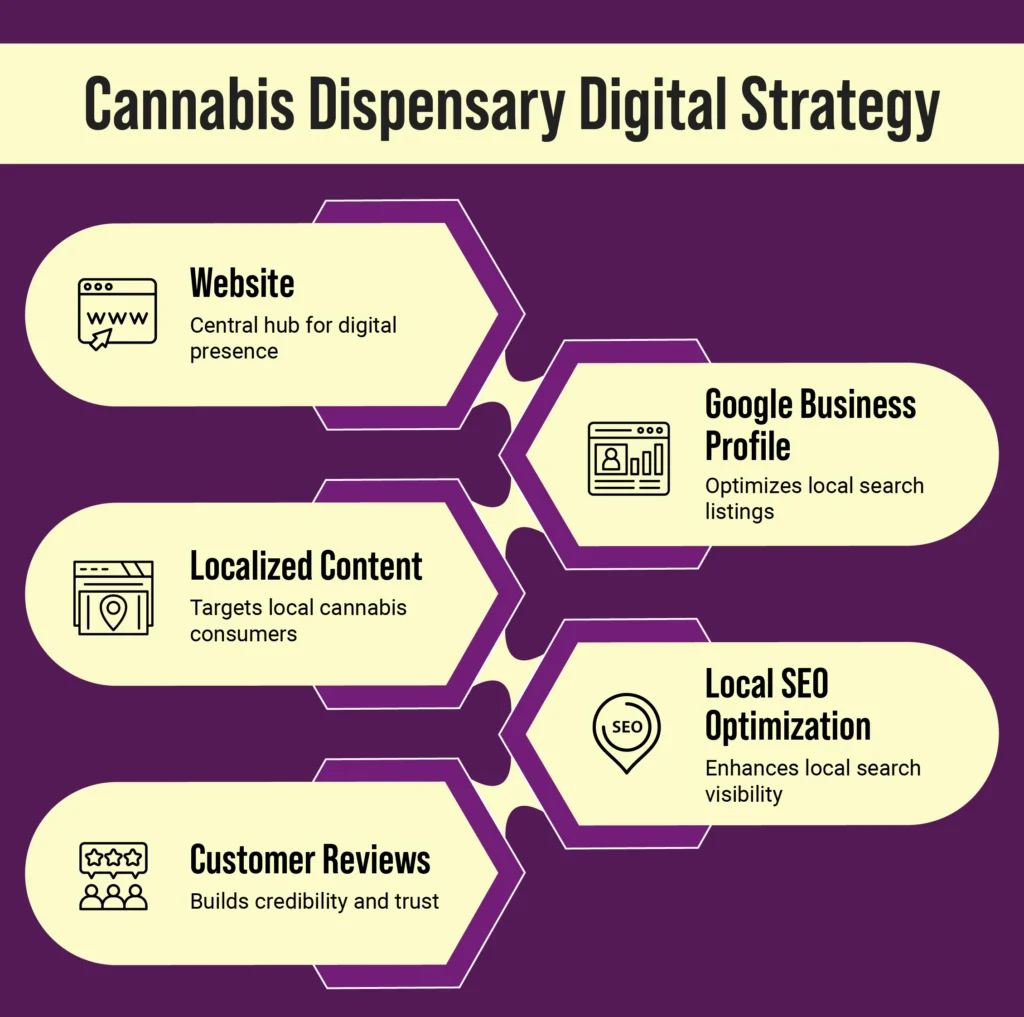
SEO tip: Target one primary keyword per page, structure content with clear headings, and ensure readability for both users and search engines.
Section 4: Social Media Marketing Without Breaking Rules
Social media is powerful for brand building, but requires strategic compliance.
4.1 Organic Content Strategies
Educational Posts: Share insights about products, usage tips, or wellness benefits without promoting sales. This positions your brand as a trusted authority.
Lifestyle Branding: Highlight community involvement, events, and the human side of your dispensary. Customers connect with authenticity.
User-Generated Content (UGC): Showcase customer stories or experiences while obtaining proper consent. UGC builds credibility and engagement.
4.2 Platform-Specific Tips
| Platform | Strategy | Notes |
|---|---|---|
Use Reels and Stories to showcase lifestyle content and behind-the-scenes footage | Avoid direct product promotion; focus on storytelling | |
| TikTok | Educational videos, product tips, wellness insights | Focus on engagement and compliance; use humor or lifestyle hooks |
| Share thought leadership, B2B insights, and partnerships | Ideal for cannabis consulting or accessory brands | |
| YouTube | Tutorials, dispensary tours, educational series | Videos must adhere to platform restrictions; focus on authority-building |
Example: A CBD brand grew Instagram followers by 35% in three months by sharing educational videos, behind-the-scenes stories, and wellness tips, all while remaining compliant.
Section 5: Email Marketing & Retention
Email marketing allows direct engagement with existing customers while staying fully compliant.
5.1 Build Your List
Use website pop-ups, in-store promotions, and social campaigns to gather email addresses.
Offer lead magnets like educational guides, newsletters, or exclusive event invites. Customers exchange their email for value.
5.2 Segmentation & Automation
Segment by customer type (e.g., recreational vs. medicinal users).
Send automated sequences for birthdays, loyalty rewards, or educational content.
Tailor content to user preferences, increasing engagement while staying compliant.
Example: A dispensary implemented automated educational emails and saw a 20% increase in repeat visits, demonstrating how proper segmentation boosts ROI.
Section 6: Paid Advertising Alternatives
Even with strict restrictions, cannabis brands can leverage creative alternatives:
6.1 Local Ads & Geofencing
Target mobile users near your dispensary. Highlight educational content or brand stories, not product sales, to remain compliant.
6.2 Programmatic Display Ads
Use cannabis-friendly ad networks that allow legal promotions. Focus on brand awareness and educational campaigns.
6.3 Influencer Partnerships
Collaborate with local or niche influencers to share educational or lifestyle content. Sponsored posts and collaborations can drive traffic while adhering to advertising rules.
Section 7: Analytics & Continuous Improvement
Data-driven decision-making ensures your campaigns remain effective and compliant:
Website Analytics: Track traffic sources, bounce rates, and conversions.
Local SEO Metrics: Monitor Google Maps interactions, direction requests, and reviews.
Email Metrics: Open rates, click-through rates, and subscriber growth.
Social Metrics: Engagement rates, reach, video views, and click-throughs.
Regularly reviewing metrics allows you to adjust campaigns for maximum ROI while staying within regulatory limits.
Section 8: Common Mistakes Cannabis Brands Make
Avoid these pitfalls to grow safely and efficiently:
Direct product promotion on restricted platforms: Risking account bans and compliance violations.
Ignoring local SEO and online reviews: Missing out on highly motivated local customers.
Neglecting email and content marketing: Failing to nurture leads into loyal clients.
Ignoring analytics: Operating blindly without measuring what works and what doesn’t.
Skipping educational content: Brands that teach, not just sell, build trust and long-term authority.
Section 9: Benefits of Partnering with My Source Digital Marketing
Partnering with an agency like My Source Digital Marketing provides cannabis brands with:
Expertise in compliance-friendly strategies: Avoid pitfalls while growing your business online.
Tailored campaigns for dispensaries, CBD, and cannabis accessory brands: Every brand is unique, and your marketing should reflect that.
Integrated solutions: SEO, social media, email, content marketing, and local campaigns work together for measurable growth.
Risk reduction: Ensure campaigns comply with all legal requirements while maximizing reach and engagement.
People Also Ask
What are the best marketing strategies for cannabis brands?
The best marketing strategies for cannabis include SEO optimization, content marketing, local SEO, and email campaigns. Cannabis brands can also use influencer partnerships, programmatic display ads, and educational social media content to grow visibility while staying compliant with advertising regulations.
Why is SEO important for cannabis digital marketing?
SEO helps cannabis brands appear in local and organic searches, attract qualified leads, and grow visibility without breaking advertising regulations.
How can cannabis businesses advertise online without getting banned?
Cannabis brands can use compliant strategies like local SEO, educational content, influencer partnerships, and email marketing instead of restricted paid ads
Conclusion: Grow Online, Safely and Effectively
Digital marketing for cannabis isn’t just about navigating advertising restrictions — it’s about creating a sustainable, compliant online presence that builds trust, engages your audience, and grows your brand. By leveraging SEO, educational content, local visibility, and creative social engagement, cannabis businesses can expand organically while staying fully compliant.
Your customers are looking for guidance and brands they can trust. With My Source Digital Marketing, you can turn digital restrictions into opportunities for growth.
Take the next step in growing your cannabis brand online safely and effectively — contact My Source Digital Marketing today for a free consultation.

